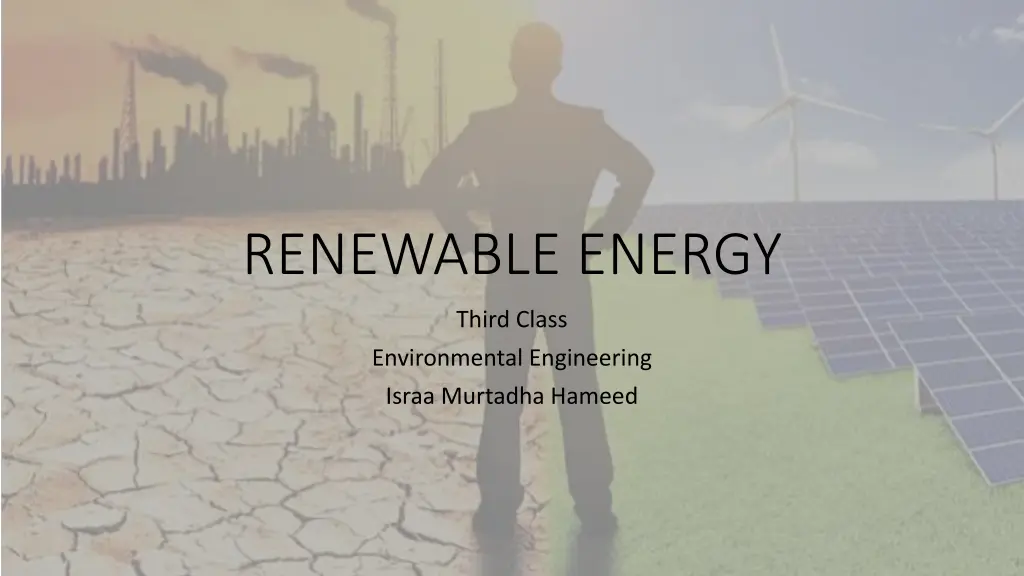
Understanding Renewable Energy in Environmental Engineering
Explore the significance of renewable energy in environmental engineering, focusing on its importance in achieving sustainable development. Learn about conventional energy sources and their impact on the environment, emphasizing the need for transitioning towards cleaner and sustainable alternatives.
Download Presentation

Please find below an Image/Link to download the presentation.
The content on the website is provided AS IS for your information and personal use only. It may not be sold, licensed, or shared on other websites without obtaining consent from the author. If you encounter any issues during the download, it is possible that the publisher has removed the file from their server.
You are allowed to download the files provided on this website for personal or commercial use, subject to the condition that they are used lawfully. All files are the property of their respective owners.
The content on the website is provided AS IS for your information and personal use only. It may not be sold, licensed, or shared on other websites without obtaining consent from the author.
E N D
Presentation Transcript
RENEWABLE ENERGY Third Class Environmental Engineering Israa Murtadha Hameed
Introduction Introduction One of the greatest challenges facing humanity during the twenty-first century is giving everyone on the planet access to safe, clean and sustainable energy supplies. During the last two centuries, humanity learned how to harness the highly concentrated forms of energy contained within fossil fuels with no regard to its reserve. This provided the power that drove the industrial revolution around the world. Nowadays there is a growing realization that the world's energy systems need to be changed radically if they are to supply our energy needs sustainably on a long term basis.
Energy and Sustainable Development Energy and Sustainable Development Energy is the capacity to do work; that is, to move an object against a resisting force. The main unit of measurement of energy is joule (J). In the context of energy, sustainability has come to mean the harnessing of energy sources that: - Are not substantially depleted by continued use. - Their use does not entail the emission of pollutants or other hazards to the environment on a substantial scale. - Their use does not involve the perpetuation of substantial health hazards or social injustices.
Types of conventional energy sources Types of conventional energy sources Many types of energy sources were found by mankind, some of them are used more than others. These types are listed bellow. 1- Fossil Fuels Fossil fuels are fuels formed by natural resources; these fuels are formed in the Earth over millions of years from decayed organisms and produce carbon dioxide when burnt. There are three major forms of fuels: coal, oil, and natural gas. - Coal is a rock mineral capable to give large quantities of energy like fire.
Types of conventional energy sources Types of conventional energy sources They are usually dug up from mountains. - Oil, also known as petroleum, is a liquid substance. Only specific oils are flammable. They are found in cave-like pockets hundreds of kilometers underground. - Natural gas is the most lethal and flammable source. It is also the most unearthed fossil fuels. Figure 1 shows the three types of fossil fuels.
These fossil fuels now supply nearly 80% of the world's current energy consumption. They are highly concentrated, enabling large amounts of energy to be stored in relatively small volumes. They are easy to distribute, especially oil and gas which are fluids.
2 2- - Nuclear Energy Nuclear Energy Nuclear energy is based on harnessing the very large quantities of energy that are released when the nuclear of certain atoms, notably uranium-235 and plutonium239, are induced to split or fission. The complete fission of a kilogram of uranium235 should produce as much energy as the combustion of over 3000 tons of coal. For that nuclear fuels are more highly concentrated sources of energy than fossil fuels. It supplies about 7% of world primary energy. However, the use of nuclear energy raise problems such as the emissions of radioactive substances, difficulties of radioactive waste disposal, and dangers from the proliferation of nuclear weapons material. Fig. 2 shows a nuclear power plant.






















